
Naruto Uzumaki is the titular protagonist of the manga Naruto, created by Masashi Kishimoto. He is a ninja from the fictional Hidden Leaf Village. As a boy, Naruto is ridiculed and ostracized on account of the Nine-Tailed Demon Fox—a malevolent creature that attacked Konohagakure—that was sealed away in his body. Despite this, he aspires to become his village's leader, the Hokage, in order to receive their approval. His carefree, optimistic, and boisterous personality enables him to befriend other Konohagakure ninja, as well as ninja from other villages. Naruto appears in the series' films and in other media related to the franchise, including video games and original video animations (OVA), as well as the sequel Boruto: Naruto Next Generations, where he is the Hokage, and his son, Boruto Uzumaki, is the protagonist.

Sakura Haruno is a fictional character in the Naruto manga and anime series created by Masashi Kishimoto. Sakura is depicted as a kunoichi affiliated with Konohagakure and a part of Team 7, which consists of herself, Naruto Uzumaki, Sasuke Uchiha, and their sensei Kakashi Hatake. Besides the main series, Sakura has appeared in several pieces of the Naruto media, most notably the spin-off Naruto: The Seventh Hokage and the Scarlet Spring (2015) and the sequel Boruto: Naruto Next Generations (2016) where she married Sasuke Uchiha taking name of Sakura Uchiha and is the mother of their daughter, Sarada Uchiha.

Sasuke Uchiha is a fictional character in the Naruto manga and anime franchise created by Masashi Kishimoto. Sasuke belongs to the Uchiha clan, a notorious ninja family, and one of the most powerful, allied with Konohagakure. Most of its members were massacred by Sasuke's older brother, Itachi Uchiha, before the series began, leaving Sasuke one of the few living. Despite becoming empathetic toward his teammates Naruto Uzumaki and Sakura Haruno, Sasuke's feelings of powerlessness force him to abandon his friends and his home in his quest to become stronger, and to find Orochimaru. Sasuke appears in several of the series' animated feature films and related media, including video games, original video animations (OVAs), and Boruto: Naruto the Movie (2015) and its manga sequel, Boruto: Naruto Next Generations (2016), in which he is depicted as a vigilante supporting his village and a mentor to Naruto's son Boruto Uzumaki.
Masashi Kishimoto is a Japanese manga artist. His manga series, Naruto, which was in serialization from 1999 to 2014, has sold over 250 million copies worldwide in 46 countries as of May 2019. The series has been adapted into two anime and multiple films, video games, and related media. Besides the Naruto manga, Kishimoto also personally supervised the two canonical anime films, The Last: Naruto the Movie and Boruto: Naruto the Movie, and has written several one-shot stories. In 2019, Kishimoto wrote Samurai 8: The Tale of Hachimaru which ended in March 2020. From May 2016 through October 2020 he supervised the Boruto: Naruto Next Generations manga written by Ukyō Kodachi and illustrated by Mikio Ikemoto. In November 2020 it was announced that he had taken over as writer on the series, replacing Kodachi.

Gaara of the Desert (我愛羅) is a character in the Naruto manga and anime series created by Masashi Kishimoto. Originally debuting as an antagonist, Gaara is a shinobi affiliated with Sunagakure and is the son of Sunagakure's leader, the Fourth Kazekage. He was born as a demon's host as part of his father's intention to have a weapon to restore their village. However, a combination of being ostracized by the Sunagakure villagers, his early inability to control the Tailed Beast, and the notion that his deceased mother called him her curse on the village caused Gaara to become a ruthless killer who believes his own purpose is to kill his enemies. Only after meeting Naruto Uzumaki does Gaara earn a change of perspective, as he eventually becomes Sunagakure's Fifth Kazekage and gains acceptance by his people. Gaara has appeared in several pieces of Naruto media, including two of the featured films in the series, the third original video animation, and several video games.

Shikamaru Nara is a fictional character in the manga and anime franchise, Naruto, created by Masashi Kishimoto. In the manga, Shikamaru is a shinobi affiliated with the village Hidden in the Leaves. He is a member of Team 10, a group of ninja consisting of himself, Choji Akimichi, Ino Yamanaka, and team leader Asuma Sarutobi. Shikamaru is portrayed as a lazy character, unwilling to apply his prodigious intelligence; Kishimoto has noted that he likes Shikamaru due to his easygoing nature. Outside the Naruto anime and manga, Shikamaru has appeared in several other media in the franchise, including video games, original video animations, and six feature films.

Rock Lee is a fictional character in the anime and manga series Naruto and Naruto Shippuden created by Masashi Kishimoto. At first Masashi designed Lee to symbolize human strength. In the anime and manga, Lee is a ninja affiliated with the village of Konohagakure, and is a member of Team Guy, which consists of himself, Neji Hyuga, Tenten, and Might Guy—the team's leader. Unable to use most ninja techniques, Lee dedicates himself to using solely taijutsu, ninja techniques similar to martial arts. Lee dreams of becoming a "splendid ninja" despite his inabilities. Lee has appeared in several pieces of Naruto media, including the third and fourth featured films in the series, the third original video animation, and multiple video games.
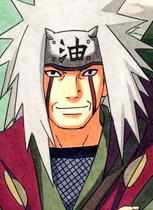
Jiraiya (自来也) is a fictional character in the Naruto manga and anime series created by Masashi Kishimoto. Introduced in the series' first part, he was a student of Third Hokage Hiruzen Sarutobi and one of the three "Legendary Great Three Students of the God Shinobi"(Legendary Sanin)—along with Orochimaru and Lady Tsunade, his former teammates. Jiraiya appears as a perverted old man who occasionally returns to the village Konohagakure, reporting the activities of Orochimaru and the organization Akatsuki. Referred to as the "Toad Sage" and "Pervy Sage", he mentors Fourth Hokage Minato Namikaze and later becomes the godfather and mentor of Minato's son, Naruto Uzumaki.

Orochimaru (大蛇丸) is a fictional character from Naruto, a manga series created by Masashi Kishimoto. Orochimaru is a former ninja from the village of Konohagakure who is well known for work in wars which earned him the title of Sannin and becomes a terrorist as a means to cheat death, and built his own ninja village Otogakure. He succeeds to some extent in obtaining immortality by transferring between different host bodies, which became one of his driving motivations throughout the series as he targets Sasuke Uchiha for his genetic heritage. By the events of Boruto: Naruto Next Generations, he has seemingly redeemed himself and has sent his experiment Mitsuki to Konoha to become a ninja. Orochimaru has appeared in media outside the Naruto anime and manga, including several video games.
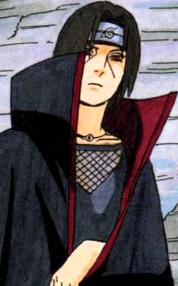
Itachi Uchiha is a character in the Naruto manga and anime series created by Masashi Kishimoto. Itachi is the older brother of Sasuke Uchiha, and is responsible for killing all the elder members of their clan, sparing only Sasuke. He appears working as a terrorist from the organisation Akatsuki and serves as Sasuke's greatest enemy.

Kakashi Hatake is a fictional character and one of the main protagonists in the Naruto manga and anime series created by Masashi Kishimoto. In the story, Kakashi is the teacher of Team 7, consisting of the series' primary characters, Naruto Uzumaki, Sasuke Uchiha, and Sakura Haruno. Kakashi's past has been extensively explored in the series, resulting in a gaiden being devoted to his past experiences. Kakashi has appeared in several pieces of Naruto media, the featured films in the series, the original video animations, and the video games.
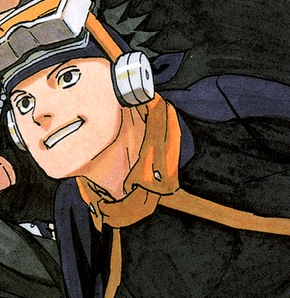
Obito Uchiha, also known by his alias Tobi (トビ), is a character in Masashi Kishimoto's manga Naruto. He is first introduced in a "Kakashi Chronicle" side story as a young ninja who sacrifices himself to save his friends after he was crushed by a landslide. Although he was believed to have died in the 3rd Great Ninja War, Obito is later revealed as the real leader of the organization known as the Akatsuki, mainly acting behind the scenes for a majority of the group's tenure. He uses the alias of his benefactor, Madara Uchiha, and conceals his true identity with masks as one of the main antagonists of the series' second half. Obito and his varied personas have appeared in Naruto video games and animated adaptations.

Boruto Uzumaki is a fictional character created by Masashi Kishimoto who first appears in the finale of the manga series Naruto as the son of the protagonist Naruto Uzumaki and Hinata Uzumaki. He later appears as the main protagonist in the 2015 anime film Boruto: Naruto the Movie where he is training as a ninja to surpass his father, the leader of the ninja village Konohagakure and also being mentored by his father's best friend and rival, Sasuke Uchiha. Boruto also serves as a protagonist in the manga and anime series Boruto: Naruto Next Generations and the sequel series Boruto: Two Blue Vortex. Both with the retelling of the Boruto film, from his early training to his growth as a ninja fighting new menaces. Boruto also appears in video games, starting with Naruto Shippuden: Ultimate Ninja Storm 4.
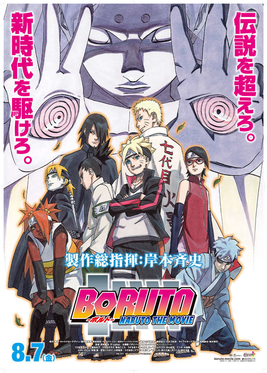
Boruto: Naruto the Movie is a 2015 Japanese animated fantasy film and the directorial debut of Hiroyuki Yamashita. It is based on Masashi Kishimoto's manga and anime Naruto, and is the second film to be a part of the canonical Naruto storyline, being a sequel to the manga series. It stars Yūko Sanpei, Junko Takeuchi, Kokoro Kikuchi and Noriaki Sugiyama. Set after the finale of Naruto, the film focuses on the title character Boruto Uzumaki, son of Naruto's protagonist, Naruto Uzumaki, who cannot stay with his family due to being the leader of his ninja village. Vigilante Sasuke Uchiha returns to the village with warnings about two beings who might become a big threat to the world peace the ninjas managed to bring about in the original series.
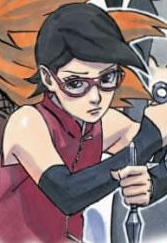
Sarada Uchiha is a fictional character in the Naruto manga by Masashi Kishimoto. Introduced in the last chapter of the manga, she becomes the protagonist of the spin-off Naruto: The Seventh Hokage and the Scarlet Spring (2015). A young ninja in training, Sarada is the daughter of Sasuke and Sakura Uchiha.

Boruto is a Japanese manga series written by Ukyō Kodachi and Masashi Kishimoto, and illustrated by Mikio Ikemoto. It initially began monthly serialization under the title Boruto: Naruto Next Generations, with Kodachi as writer and Kishimoto as editorial supervisor in Shueisha's shōnen manga magazine Weekly Shōnen Jump in May 2016, and was transferred to Shueisha's monthly magazine V Jump in July 2019. In November 2020, Kodachi stepped down, with Kishimoto taking over as writer. In April 2023, the series concluded the first part of the story and, following a brief hiatus, continued in August of the same year with a second part titled Boruto: Two Blue Vortex. Boruto is a spin-off and a sequel to Kishimoto's Naruto and follows the exploits of Naruto Uzumaki's son, Boruto Uzumaki, and his ninja team.

Naruto: The Seventh Hokage and the Scarlet Spring is a spin-off manga written and illustrated by Masashi Kishimoto. Its plot, set shortly after the epilogue of the Naruto series, focuses on Sarada Uchiha, a young ninja in training from a country called Hinokuni. Sarada is concerned about the identity of her absent father, Sasuke Uchiha, and whether Sakura Uchiha is her birth mother. Sarada goes on a quest to confirm her origins, during which she confronts a group of people who want to kill her father.
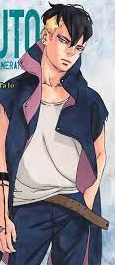
Kawaki is a fictional character from Ukyō Kodachi and Mikio Ikemoto's manga Boruto: Naruto Next Generations. Initially appearing in the flashforward in the series' debut, Kawaki is a young man who apparently would become the nemesis of the series' lead character, Boruto Uzumaki. Kawaki is later introduced as a rebellious member from the organization Kara who wishes to escape and remove his cursed mark "Karma" from his body. In his escape he meets Boruto's ninja team, who take him to the Hidden Leaf Village. Naruto takes the teenager under his wing, seeking to protect him from enemies, and he bonds with the family as time passes, beginning to view Naruto as a father-figure and Boruto as a foster brother, like Sasuke in the past Naruto series, with similar attitude.



















